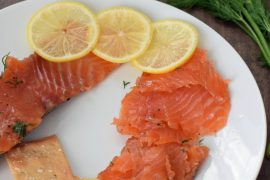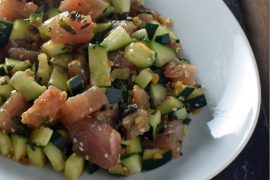 |
| Cajun and Creole dishes at Ignatius Eatery; from top left: Seafood Gumbo, Jambalaya, Crawfish Étouffée, Shrimp Creole |
This is the second part of New York Food Journal‘s Beyond the Five Boroughs feature on New Orleans. The first post was on the city’s street food, snacks, and sandwiches and the third post was on Chef John Besh’s Restaurant August and Lüke.
New Orleans is probably best known for its Cajun and Louisiana Creole food. Cajun and Creole cuisines are similar (and the words are often used interchangeably) — they both make copious use of the so-called “Holy Trinity” variant of mirepoix, which consists of onions, bell peppers, and celery in roughly equal proportions — but there are some distinct differences. Cajun food is heartier, usually spicier, and less refined; such as boudin sausages.
Both cuisines have French influence, and also combines other cuisines such as Spanish, Italian, African-American, Southern and others. Cajun food is also not exclusively Southern; in fact, the Cajuns descended from French colonists in Acadia in present day Quebec and Northeastern Maine and only settled in Louisiana after they were deported by the British during the French and Indian War.
In any event, and perhaps more importantly, both Louisiana Cajun and Creole food are delicious. The two cuisines include such familiar dishes as gumbo, jambalaya, étouffée, shrimp (or other shellfish) Creole, and anything containing crawfish. These dishes are all excellent and make good use of local flavors.
Traditional Cuisine at Ignatius Eatery
A great example of traditional Louisiana Cajun and Creole cuisine can be found at Ignatius Eatery in the Uptown neighborhood. (Incidentally, for a New Yorker, the “Uptown” name threw me off, since the neighborhood is located south of the Central Business District, other commercial areas, and the French Quarter, which one would normally associate with being “Downtown). The restaurant is presumably named after the character Ignatius from the venerable book A Confederacy of Dunces that is set in 1960s New Orleans. It is also BYOB, which is always a nice touch.
Many of the traditional dishes offered here trace their origins to hundreds of years ago and all require an affection for rice.
The Seafood Gumbo here was excellent, its dark base indicative of its Cajun rather than Creole roots — the roux cooked to a few shades lighter than burning and filed with a good amount of crawfish. As with many Cajun dishes, it’s topped with rice and green onions
Jambalaya is a Creole dish that combines French, Spanish and American cooking. One story has it that it was started by Spanish immigrants in New Orleans who were trying to make paella but used tomatoes as a substitute for the expensive saffron. I find this story dubious since different rice is used in each dish and the preparation is completely different. And I think the dish should stand on its own, rather than as a substitute for paella — especially since it is so hard to find decent paella these days. At Ignatius, the Jambalaya was nicely cooked, without the rice being too dry or soggy and the sausage was nicely spiced.
| Bread Pudding |
Étouffée (literally “stifled,” “smothered,” or “suffocated” in French) is another Louisiana Creole dish consisting of roux, holy trinity, seasoning, and seafood. The yellowish color is apparently from the crawfish fat, which turns yellow when cooked. This was a surprisingly creamy dish, slightly spicy, and with good pieces of crawfish, though it was not quite as successful as the other Creole dishes that night.
Shrimp Creole is another dish incorporating the holy trinity but unlike the other dishes does not involve roux. Instead, the shrimp are cooked in a cayenne and tomato based sauce. This was probably my favorite dish at Ignatius: the shrimp were cooked perfectly and the sauce was spicy without being overpowering
For dessert, try the bread budding, which was unbelievably decadent.
Jacques-Imo’s Cafe
| Alligator Cheesecake |
Jacques-Imo’s Cafe‘s menu is divided evenly between “everyday favorites” which are more traditional Creole and Cajun dishes, like those discussed above, and “Specials” which are Cajun and Creole inspired dishes. The restaurant has been around since the 1990s and is extremely popular, helping to revive the Oak street area of Uptown.
Jacques-Imo’s is perhaps best known for their “Alligator Cheesecake” — which is, of course, not a cheesecake, but rather a savory, spiced, quiche-like dish with alligator sausage. It’s unclear why they kept the cheesecake name but perhaps it’s to enhance the supposed novelty of eating alligator. Of course, covered in so many spices and cheeses, it’s hard to discern the alligator taste. Nevertheless, I did like the dish; the spices were flavorful and the consistency was unusual — it’s a little creamier than a quiche and overall was tasty but probably not worth all the hype.
The stuffed shrimp was a better appetizer, lightly breaded and sitting on top an excellent magnolia sauce.
| Cajun Bouillibaisse |
Each entree is gigantic. They come with two sides like corn maquechoux (awesome), cabbage (meh), beets (well cooked; under-seasoned), and French fries (great), as well as a greens salad topped with a fried oyster in a sesame dressing. The fried oyster was the best one I had in New Orleans and was a great addition to the meal, and proves the point that oysters make almost any meal better.
The Cajun Bouillibaisse stood out to me among the entrees — this huge portion of oysters, shrimps, mussels, and fish in a spicy and savory tomato broth with garlic cheesy bread makes great use of local seafood, and Cajun spices, but is different from traditional Cajun recipes. The addition of the oysters to the bouillibaisse was a great touch; and I don’t think I had ever had oysters in a fish soup before — they should be there more often!
Crawfish
| The Crawfish Boil at Maple Leaf Bar |
Louisiana supplies close to 100% of the crawfish harvested in the United States and sources a large portion of the worldwide demand (where it is often called “crayfish” for some reason).
A review of New Orleans Cajun and Creole cuisine would not be complete without a mention of the crawfish boil at Maple Leaf Bar which I was told takes place every Sunday night. This bar, which, incidentally, is down the street from Jacques-Imo’s serves hundreds of crawfish, boudin sausages, and other accompaniments strewn on fold-up tables in the middle of the bar for $10. While this arrangement would in no doubt not make a New York City health inspector happy, it was a raucous event worth attending.
Crawfish look like small lobsters and taste a little like shrimp, but are chewier. Most of the meat is in tail but some people go all out and suck the head as well as the claws. When in Rome.
Make sure you get there before 10 PM, when the ravenous crawfish seekers will have picked them clean. (It opens at 7).
View New Orleans Cajun & Creole Cuisine in a larger map
Ignatius Eatery: 4200 Magazine Street, New Orleans, LA 70115; (504) 896-2225 (no website)
Jacques-Imo’s Cafe, 8324 Oak Street, New Orleans, LA 70118; (504) 861-0886;
jacquesimoscafe.com/
Maple Leaf Bar, 8316 Oak Street, New Orleans, LA 70118; (504) 866-9359;
mapleleafbar.com




Now that you've had the real thing, are there any Creole or Cajun places you'd recommend in the City?
Unfortunately, I don't. Not that Acme has turned Scandinavian on us, I'm out of ideas. Any you recommend?
Tchoup Shop at d.b.a. is both delicious and very authentic.
Ive worked at Ignatius, the food when you reviewed it came from either frozen bags (http://www.drgumbos.com/) or a box/can (http://www.zatarains.com/Products/Rice-Mixes-and-Side-Dishes/Jambalaya-Mix-Original.aspx). After moving to a new location some items are made from scratch and it has been updated slightly–with much resistance from the owners–with the exception of the etouffe, jambalaya, red beans (http://www.kajunkettle.com/products.html#neworleans), a few others. Essentially this is food that is heated and served from a steam-well, a la Piccadilly. There is no authenticity, no desire to serve excellent food that represents the region, just a business looking to make some money and incidentally fool a few tourists in the process.
A couple of observations/corrections. 1) Ignatius is probably the worst place in the city to try these foods. 2) Jambalaya is derived from the words Jambon (Ham) and yaya (african for rice) – most versions contain ham and the difference between creole Jambalaya and cajun Jamblaya is that creole uses tomatoes. 3) the cheese cake at Jacques Imos is actually a cheesecake, although it is savory. It has a cream chease base and few eggs. It is made with aligator sausage, and not straight aligator meat. Finally, the sausage in a crawfish boil is NOT boudin, but likely smoked or andouille. Boudin is a mixture of rice and liver that is steamed and very delicate – would not withstand cooking in a boil.
Uptown refers to "up river". I know we are backwards down here. Haha
This guy is clearly from New York and has no idea what good authentic Louisiana cuisine should taste like….if he did, he'd know that it is nothing like any of the bland food he ate here.
Great writeup. I'm loving the trend of traditional southern/cajun/creole food becoming an international delicacy. Chef Robert is cooking a delicious cajun and creole feast on April 4th: http://melba.co/feasts/228
Seriously reconsider taking any of this guy's opinions as trustworthy. He got an out of towner's experience for "local." I've never met a single third or more generational Louisiana resident say anything positive about Ignatius.
Most of the places that are so cherished in Uptown are cherished by people who have recently moved to New Orleans. The vast majority of the great, traditional New Orleans food has moved to Metairie, Kenner, Mandeville, Slidell. The city itself is really a shell of itself and especially Uptown and the French Quarter are images of what out of towners think New Orleans is.
Ignatius sucks.
Jacques Imos sucks.
Is either owner from Louisiana?
But you're more interested in being "authentic" to out of towners than you are being accurate.